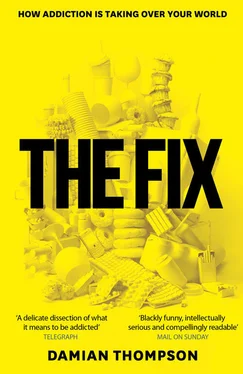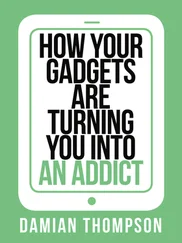‘And – just my prejudice this – but perhaps the ultimate emptiness of cupcakes, those empty calories, the way they never deliver on flavour what they promise in looks, is a metaphor for the hopelessness of the woman, or man, with bulimia.’
Although a high proportion of bulimics have ‘issues’ with cupcakes, clearly the overwhelming majority of people who eat them don’t throw them up. They do, however, seem obsessed with them. A chain called Crumbs sells 1.5 million cupcakes every month in 35 US stores; in June 2011, it started trading on the Nasdaq, with an opening valuation of $59 million. And market analysts predict robust growth if Crumbs moves into emerging markets such as China.
The Facebook group for Sprinkles Cupcakes had, at the time of writing, been ‘liked’ by 325,000 people and was spreading the cupcake gospel with near-hysterical enthusiasm. 7 Конец ознакомительного фрагмента. Текст предоставлен ООО «ЛитРес». Прочитайте эту книгу целиком, купив полную легальную версию на ЛитРес. Безопасно оплатить книгу можно банковской картой Visa, MasterCard, Maestro, со счета мобильного телефона, с платежного терминала, в салоне МТС или Связной, через PayPal, WebMoney, Яндекс.Деньги, QIWI Кошелек, бонусными картами или другим удобным Вам способом.
For Valentine’s Day: ‘It’s back! The first 50 people to whisper “love at first bite” at each Sprinkles receive a free raspberry chocolate chip!’ For Super Sunday: ‘Whether you’re rooting for the New York Giants or New England Patriots or just tuning in for the commercials, Sprinkles Super Sunday boxes will score a touchdown at any viewing party. Each box contains 6 Red Velvet and 6 Vanilla cupcakes, adorned with football sugar decorations and your favourite team’s name. Just don’t get tackled reaching for the last one!’ There were even signs that cupcakes were trying to infiltrate the military-industrial complex: ‘Sprinkles is excited to bring freshly baked cupcakes to the Pentagon! Pentagon employees can find us in the Main Concourse …’
This is a resilient craze, as Dana Cowin, Food & Wine magazine’s editor-in-chief told Reuters in 2011. ‘I have predicted the demise of the cupcake so many times that I’m actually going to go to the dark side now and say the cupcake trend is not going to abate,’ she said. 8 Конец ознакомительного фрагмента. Текст предоставлен ООО «ЛитРес». Прочитайте эту книгу целиком, купив полную легальную версию на ЛитРес. Безопасно оплатить книгу можно банковской картой Visa, MasterCard, Maestro, со счета мобильного телефона, с платежного терминала, в салоне МТС или Связной, через PayPal, WebMoney, Яндекс.Деньги, QIWI Кошелек, бонусными картами или другим удобным Вам способом.
When an earthquake struck Washington DC on 23 August 2011, someone tweeted that you could tell it had happened because there was suddenly no line outside Georgetown Cupcakes.
Could the ‘emptiness’ of the cupcakes to which Xanthe Clay refers be part of their appeal? Their overwhelming sugar hit fills the consumer with what nutritionists call ‘empty calories’, because they have no nutritional value. But that’s not to say they have no mood-altering value. Sugar triggers production of the brain’s natural opioids, according to Princeton neuroscientist Bart Hobel, who led a study into sugar dependence. He found that rats which binged on sugar went into withdrawal when the supply was cut off. ‘We think that is a key to the addiction process,’ he said. ‘The brain is getting addicted to its own opioids as it would to morphine or heroin. Drugs give a bigger effect, but it is essentially the same process.’ 9 Конец ознакомительного фрагмента. Текст предоставлен ООО «ЛитРес». Прочитайте эту книгу целиком, купив полную легальную версию на ЛитРес. Безопасно оплатить книгу можно банковской картой Visa, MasterCard, Maestro, со счета мобильного телефона, с платежного терминала, в салоне МТС или Связной, через PayPal, WebMoney, Яндекс.Деньги, QIWI Кошелек, бонусными картами или другим удобным Вам способом.
Opioids are also implicated in bulimia, irrespective of whether sugar is involved. Have you ever experienced that feeling of glorious relief after you’ve just thrown up a dodgy curry? It’s not just getting rid of the food that makes you feel good; it’s a natural elation produced by chemicals in the brain. Bulimics get off on it, to put it crudely.
As Abigail Natenshon explains: ‘The bulimic cycle releases endorphins, [opioid] brain chemicals that infuse a person with a sense of numbness or euphoria. Ironically, the relief passes in short order, only to be replaced by anxiety and guilt for the bulimic behaviours.’ Again, we need to state the obvious fact that most people don’t throw up their food. But the sort of food associated with purging is also the sort of food that many of us have difficulty resisting, because its heavy concentrations of sugar, fat or salt can magnify euphoria and neediness.
It’s easy for urban sophisticates to mock American rednecks or British ‘chavs’ who stuff themselves with fast food, and easy to recognise that they’re in the grip of some sort of addiction. Just look at their waistlines. But the marketing executive who orders a cranberry muffin to go with her morning cup of coffee really ought to ask herself: why am I eating cake for breakfast?
So what about the iPhone? Isn’t it a bit much to call our love affair with this shiny gadget an ‘addiction’? Researchers at Stanford University aren’t so sure: in a survey of 200 Stanford students in 2010, 44 per cent of respondents said they were either very or completely addicted to their smartphones. 10 Конец ознакомительного фрагмента. Текст предоставлен ООО «ЛитРес». Прочитайте эту книгу целиком, купив полную легальную версию на ЛитРес. Безопасно оплатить книгу можно банковской картой Visa, MasterCard, Maestro, со счета мобильного телефона, с платежного терминала, в салоне МТС или Связной, через PayPal, WebMoney, Яндекс.Деньги, QIWI Кошелек, бонусными картами или другим удобным Вам способом.
Nine per cent admitted to ‘patting’ their iPhone. Eight per cent recalled thinking that their iPods were ‘jealous’ of their iPhones. These are strange things for students at one of America’s top universities to say about their phones, even in jest. They also reveal something about how completely the iPhone has become part of these students’ identities and social frameworks. They’re not just tools that allow us to connect instantaneously and prolifically with others: they’re also being afforded identities of their own – ‘patted’, protected and cherished.
Perhaps it has something to do with how these devices are engineered. They practically force you to perform repetitive rituals of the sort associated with obsessive-compulsive behaviour: from the initial activation of the iPhone to the weekly ‘syncing’ and nightly charging, your relationship to the phone is structured for you. And because the iPhone’s battery life isn’t quite enough to last a full day’s use – and certainly not long enough to withstand hours of constant fiddling and gaming – ‘pit stop’ charges become a regular feature of the day. iPhone users can often be seen checking for power sockets in coffee shops so that, while they get their own fix of caffeine, their phones can get juiced up as well.
Читать дальше












